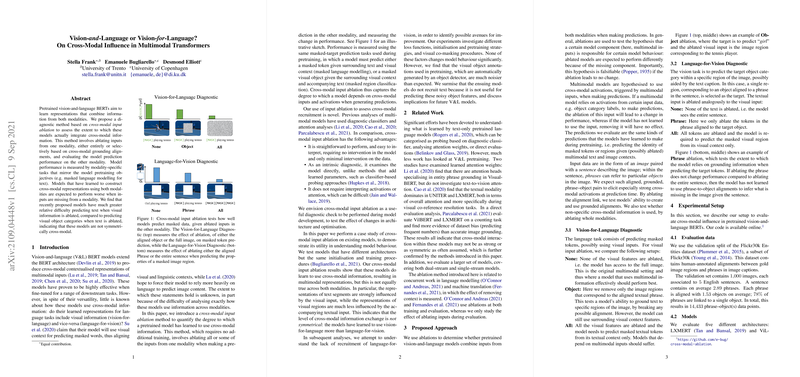Analysis of Cross-Modal Influence in Multimodal Transformers
The paper presented in the paper, "Vision-and-Language or Vision-for-Language? On Cross-Modal Influence in Multimodal Transformers," provides a diagnostic analysis of vision-and-language BERT models, focusing on how these models integrate cross-modal information during pretraining. The research is premised on evaluating whether these multimodal transformers effectively leverage visual context in language tasks and linguistic context in vision tasks.
Objective and Methodology
The authors propose a novel diagnostic method, cross-modal input ablation, to assess the extent of cross-modal integration in multimodal models. This involves selectively ablating inputs from one modality and assessing the model's ability to predict masked data from the other modality. Performance metrics are aligned with the model's pretraining objectives, such as masked LLMing (MLM) for text and masked region classification (MRC-KL) for visual data. The paper hypothesizes that models effectively utilizing cross-modal inputs should demonstrate degraded performance when inputs from a modality are missing.
Key Findings
The experimental results reveal a significant asymmetry in cross-modal representation within these models. The models exhibit greater difficulty with text prediction tasks when visual data is ablated compared to visual property prediction when language data is ablated. This suggests a stronger vision-for-language integration compared to language-for-vision integration. These findings challenge assumptions of balanced cross-modal interactions in existing multimodal transformers.
The paper also explores potential reasons behind this asymmetry. Initial explorations include assessing various pretraining architectures, loss functions, initialization strategies, and co-masking techniques. However, these interventions did not significantly alter the model's recruitment of language-for-vision.
A critical insight was the identification of noise in the silver object annotations, produced by an object detector, which likely discouraged models from integrating linguistic context effectively in visual tasks. Analysis on a subset of data with correctly matched labels did not alter outcomes, reinforcing the influence of noisy labels on cross-modal dependencies.
Implications and Future Directions
This paper's findings underscore the need to re-evaluate the design and training paradigms of multimodal BERTs, particularly when symmetry in cross-modal interactions is essential. The diagnostic tool introduced can serve as a useful strategy for model developers to test and ensure balanced cross-modal influences in future architectures.
Practically, ensuring high-quality training labels—especially for the visual tasks—might enhance the model's ability to integrate language context effectively. From a theoretical standpoint, this paper prompts a reconsideration of the model pretraining objectives and dataset compositions to foster balanced development of cross-modal representations.
Looking forward, exploring more language-for-vision tasks and integrating robust, human-generated visual annotations could drive advancements in multimodal AI, allowing these models to be more bidirectionally integrative. This approach might not only improve existing applications but could also unlock new domains where understanding and generating multimodal content is crucial.
In summary, this work provides compelling evidence of the directional bias in multimodal transformers and introduces a new method to diagnose and potentially rectify such biases, making it an important contribution to the field of AI research.
